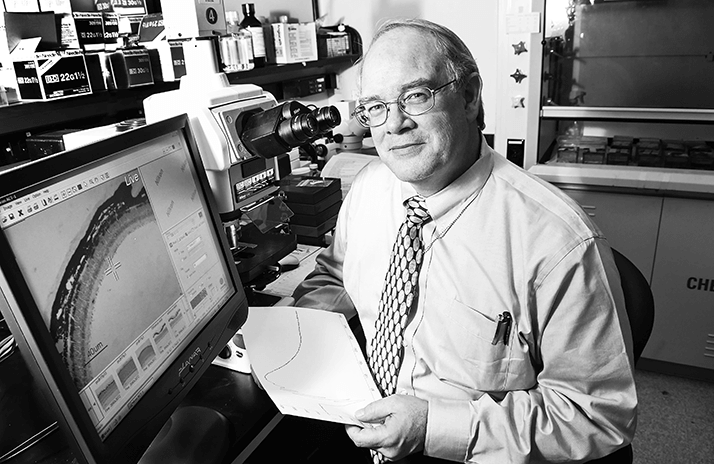
How did you end up where you are today? I’m interested in people, but also in physics – two areas that don’t typically go together. My interest in helping people motivated me to learn medicine, but once I started, I developed a particular interest in the workings of the eye, and especially the retina. I enjoy finding out how things work and why they fail, which is kind of an engineering approach to medicine – so the way vision works, with all the complexities of light refraction and absorption, appeals to my background in physics and my inclination toward engineering. Ophthalmology was a good combination of all the things I wanted to do.
After the first human genome was published, the importance of genetics became obvious. I was studying night blindness – and I could examine cells, calibrate light intensities, check peripheral vision, and ask about family histories, but none of that gave me a fundamental insight into the problem. I’m interested in why things happen, which is very hard to get your hands on. The easiest way is to find patients with a family history of disease and then study those families to identify the gene of interest. That way, you can get a handle on the pathophysiology of the disease. Genetics is a marvelously complex subject area, but it’s also a tool – a key that unlocks the door to the biology of retinal disease.
How do you divide your time between research and administration? I want to emphasize that I continue to do science. I see it as a vital part of my responsibilities – it’s important for me to talk to knowledgeable scientists and clinicians. So in addition to my administrative duties, I maintain a laboratory at the National Institutes of Health (NIH), where I work in the evenings and on weekends. It turns out that I’m not the only one – about half of NIH directors maintain active research programs.
What’s your management style? My management style lets me expand beyond my own capabilities. I look for people who are excited about a job or idea I want to investigate, and hire them to focus on it. Over the course of the 14 years I’ve been at the National Eye Institute (NEI), I’ve been fortunate to find a number of hardworking, responsible people to join my team. I coordinate the “big picture,” but these kinds of jobs are far too extensive for any one person to tackle, so I’m always looking for smart people to join the institute. I learn a lot from them, too; each person I work with has their own way of thinking. When I talk to them, I listen carefully so that I understand their needs, and then I can accommodate those things. I don’t know if I’m a great communicator, but I try.
What’s exciting you about your research at the NEI at the moment? At the moment, I’m very proud because our lab has just received all the necessary regulatory approvals to begin human gene therapy studies in men with X-linked retinoschisis – structural splitting of the retina. We’re now doing a gene therapy trial with a vector we developed in our laboratory. In an animal model, we were able to rescue the retinoschisis phenotype, so now it’s time to take that work to humans. We’ve already injected several individuals with our new vector, so we’re hoping to see some success soon.
Is this your career highlight to date? The new trials aren’t the only thing I’m proud of in my career. I’ve been fortunate enough to do a number of things that have been extremely gratifying. Many involved understanding the genetic pathologies of particular families, creating animals that have human equivalent diseases, and developing gene therapies for those diseases. I recently spoke at the NEI’s Audacious Goals development meeting and used the words “seamless science,” because I see science and medicine as a fabric that extends from all corners – but if you trace your way back through it, you can see where it’s come from and which researchers and discoveries have turned it into what it is today.
What advice do you have for others who want to follow in your footsteps? Follow what interests you, and if it interests you very deeply, don’t worry about the money (unless you can’t buy the bread and the butter). That’s the advice I’ve always tried to follow. A lot of scientists and research clinicians my age are looking back and thinking that we had an easier time getting our careers off the ground 20, 30, or even 40 years ago. The current climate is particularly rigorous for people who are just starting out. There are a number of roadblocks: research funding is tight even as opportunities are burgeoning, and the complexity of science has grown as we’ve acquired new knowledge and resources. I feel strongly – as do my colleagues – that society needs to rekindle support for research.
